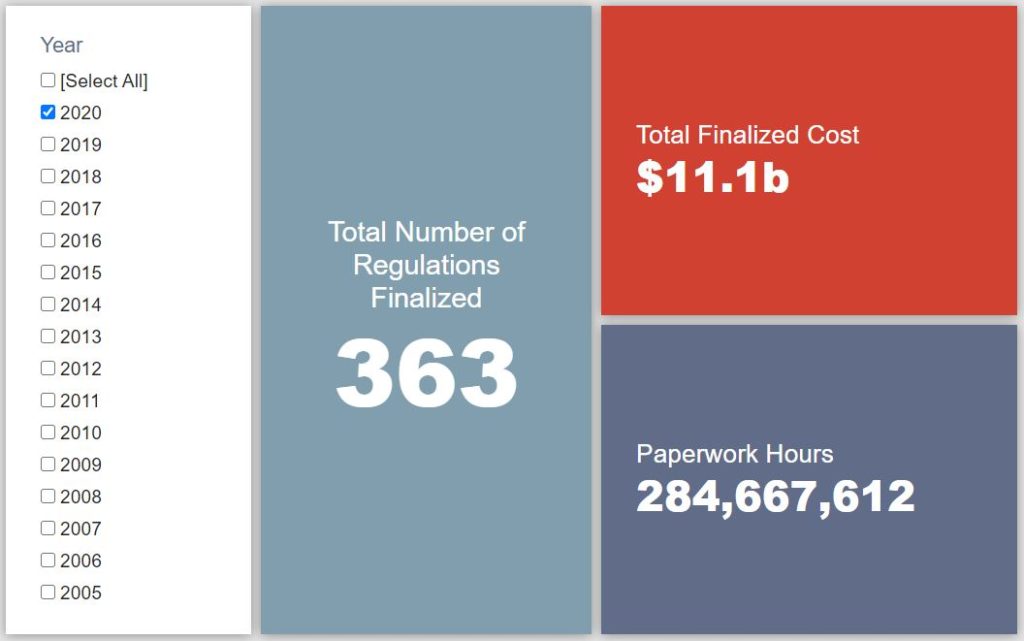Week in Regulation
November 16, 2020
Health Care Rule Pulls 2020 into Net-Costs Column
Last week was a moderately active one in terms of regulatory activity. Across 13 rulemakings with some measurable economic impact, there was a handful of rules with some significant impact. One health care rule, however, towered over the rest and single-handedly moved the calendar year 2020 final rule tally into cost-adding territory. Across all rulemakings, agencies published $34.3 billion in total net costs and added 57.1 million hours of annual paperwork.
REGULATORY TOPLINES
- Proposed Rules: 36
- Final Rules: 58
- 2020 Total Pages: 72,810
- 2020 Final Rule Costs: $11.1 billion
- 2020 Proposed Rule Costs: $17.4 billion
TRACKING THE REGULATORY BUDGET
The aforementioned rule out of the Department of Health and Human Services (HHS) was far and away the most consequential rule of the week in terms of the fiscal year (FY) 2021 regulatory budget. The rule regarding “Transparency in Coverage” seeks to expand the amount of information health insurance issuers have to disclose to their customers on such items as cost-sharing arrangements and in-network versus out-of-network rates. Much of the costs from these requirements are administrative in nature. In fact, HHS estimates that the rule would add more than 57 million hours of paperwork each year, contributing to annualized costs of roughly $2.4 billion, or nearly $34.5 billion in present value. These estimated costs actually represent an increase in order of magnitude from the rule’s proposed version ($129 million annually or $1.8 billion in present value).
While the administration’s FY 2021 regulatory budget caps are still forthcoming, so far this fiscal year agencies have officially published 31 deregulatory actions and 9 regulatory actions, totaling $35.3 billion in quantified total net costs. The American Action Forum’s review of the administration’s FY 2020 regulatory budget progress can be found here.
THIS WEEK’S REGULATORY PICTURE
This week, the incoming Biden Administration announces its agency review teams.

Source: https://wgetsnaps.github.io/biden-harris-transition-teams/index.html
On November 10, the Office of the President-Elect announced the individuals that will make up the Biden Administration agency review teams. The job of the teams is to help the incoming administration get up to speed on the policies and regulatory actions the Trump Administration has been working on. Traditionally, they work with an outgoing administration to understand specific challenges and opportunities agencies face. This year’s transition could be undermined somewhat by the fact that President Trump, and his appointee at the General Services Administration, has yet to recognize the outcome of the presidential election.
While the teams are comprised of individuals currently working in private sector, the list includes a number of former high-ranking agency officials – primarily from the Obama Administration.
Examples include Chris Lu and Seth Harris, former Department of Labor deputy secretaries; Cynthia Giles, who headed the Environmental Protection Agency’s enforcement office; and Leandra English, a former Obama Administration Consumer Financial Protection Bureau (CFPB) office who became involved in a battle for CFPB control during the Trump Administration.
The teams, and the individuals serving on them, offer more clues that regulatory policy under the Biden Administration will be something of an extension of the Obama Administration. This shift back to Obama-era policy could be confirmed once the president-elect begins naming his nominees for agency leadership later this month.
TOTAL BURDENS
Since January 1, the federal government has published $28.6 billion in total net costs (with $11.1 billion from finalized rules) and 342.1 million hours of net annual paperwork burden increases (with 284.7 million hours due to final rules). Click here for the latest Reg Rodeo findings.












